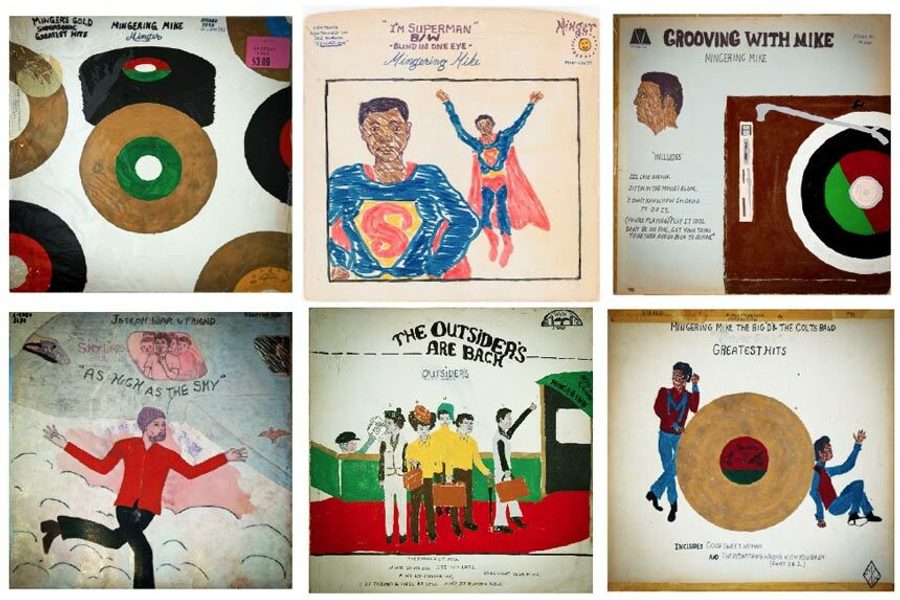A Cover Artist, Discovered—40 Years Later
Mingering Mike had all the requisites for a legendary music career, except the music.
Chris Lehmann

In the interlocking ’60s-era revolutions in pop, soul and rock ‘n’ roll, there was an inchoate sense of communal promise — a belief that a new gathering of voices hymning new variations on age-old themes of generational revolt, social protest and personal longing could break through to a mass audience. That disaffected artists, formerly consigned to the bohemian margins, need no longer feel quite so alone.
In the fulcrum of this shift, the African-American artist known today as Mingering Mike began to register the impact of these upheavals on his own vulnerable young life. Growing up in the grimmest reaches of Washington, D.C., in the ’60s, the boy had lived in 13 different neighborhoods by the time he was 18. His mother died when he was 5, and his troubled father bailed out not long afterward. An older sister raised him, and while she looked after him as best she could, her alcoholic and abusive husband was a constant threat.
In contrast, the soul music of his youth preached love, optimism, independence, self-assurance — and rebellion. So, like millions of other American young people in the 1960s and 1970s, he sought to carve out a life for himself in that other, more accommodating world. He tried to coax new songs out of a “cheap toy guitar,” but, he recalls, his main connection to music was visual: “When I was 15 and drawing a lot, all of a sudden, names of songs that I never heard of would pop in my head, but I didn’t have the knowledge to write.” Mike crafted a persona around the made-up name “mingering” — a hybrid of mingling and merging — and created an amazing body of imaginary soul records, hand constructed from cardboard and lavishly annotated. He invented imaginary record labels — Puppy Dogg, Ming-War, and Fake Records, among others — and outfitted them with titles from a sprawling catalogue of fictitious Mingering Mike songs.
Notification from the Selective Service came in 1969, the year he turned 19: His draft number had come up. He didn’t show up for deployment to Vietnam, and proceeded to spend most of the 1970s afraid to leave his apartment or seek a steady job, lest he be sent to prison. In seclusion, however, his alternate persona blossomed, and the result was more than 150 faux LPs and singles between 1969 through 1977, when the newly inaugurated Jimmy Carter declared amnesty for draft resisters. Mingering Mike became a vocal critic of the war; a concept album titled “You Only Know What They Tell You” bears the legend, “The United States of America Puppet Force.”
This sounds grim and confrontational — more KRS-1 than Marvin Gaye. But the Mike persona is also wickedly funny. A 45 he made in 1969 for a group called the Freedom Stompers features a Nixon-like figure announcing to a crowd “Peace will come” — and a black figure behind him, confined like Nixon in ball and chains, answering “Yes, probably when we’re all dead from hatered [sic].”
How Mingering Mike came to public attention is now the stuff of D.C. legend. In 2003, a soul record collector, Dori Hadar, stumbled upon a crate full of odd-looking albums at an outdoor flea market. The graphics were hand drawn with cheap felt pens and magic markers, but the accompanying text was long on descriptive detail. When he reached inside the record sleeves, Hadar pulled out cardboard facsimiles of vinyl records, most of which even had grooves lovingly hand drawn on them.
“I thought that they were like prototypes for albums I never heard of by some guy I never heard of,” Hadar recalls. “The song titles were amazing, the lyrics were amazing. I wanted them to be real. But the more I looked at them … it became clear that this was all by one person.” Hadar’s day job was as a criminal investigator. He tracked down the storage space that had disgorged the crate full of Mingering Mike records. A handful of bills produced a name, and a few phone calls to relatives turned up the man himself.
Mike, an intensely private and shy man, would at first only talk to Hadar through the door of his apartment. “We had this bizarre discussion over breakfast at Denny’s,” Hadar says, “where I had to explain that I had all this work of his, and had posted it on Soulstrut” — a popular D.C. website for vintage record collectors. The news that his work had drawn an avid following was not thrilling to someone like Mike, who had spent most of his life avoiding encounters with people he didn’t know. “It was like taking his diary and putting it online,” Hadar says. So he took down what he had posted.
Following that, however, Hadar and another Mingering Mike collector gave the real-life Mike a taste of how his work had been greeted, reading him printouts from Soulstrut. And so the imaginary soul star, who’d retired in 1977, was abruptly plunged into that weird and in many ways scarcely less imaginary form of 21st-century renown: online celebrity.
When I was able to reach Mike on the phone, he was, as expected, slow to warm up to an interview. But when the talk turned to what inspired his creations, he spoke in the excited cadence of the true fan. I noted that his musical influences — James Brown, Marvin Gaye — were clear enough, but I was trying to puzzle out his comedic influences. “Are you familiar with Stan Freberg?” he asks, name-checking a political satirist known for his parodies of McCarthyism. “When you admire something so much it becomes a part of you, you pick it up and make it your own,” he explains.
Today, Mike is on the verge of real-life stardom. At the end of February, the Smithsonian American Art Museum debuted an exhibit, “Mingering Mike’s Supersonic Greatest Hits,” which will run until August 2. His story has yielded one movie option, and another film-documentary project may be in the works. Former Talking Heads frontman David Byrne had sought to broker a tribute album, but that project fizzled when Byrne tried to claim the publishing rights.
But the most promising development of all is the prospect that Mike will resume recording his own material. In collaboration with one of his cousins, he had laid down some tracks back in the 1970s over vocalized rhythm backing (“some people say I invented the beat box,” he says), and virtually all the tracks presented on his album covers exist in some state of composition.
I ask him if Mike today would take up his old protest mantle — singing, say, about the non-indictments in the police killings of Eric Garner and Michael Brown. He pauses, then says, “I probably wouldn’t have the people’s name in it. I would just have the feelings people conveyed to one another or as they saw it on TV. Most of the time you need something that’s funny, to get people out of the cycle of being blasé, and saying, ‘Well, I knew that was gonna happen.’ ” At which point he name checks yet another postwar Jewish comedian: “Just like Alan Sherman — you remember him?”









